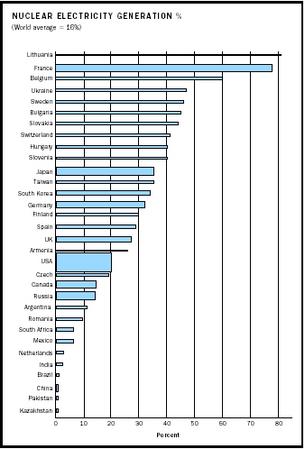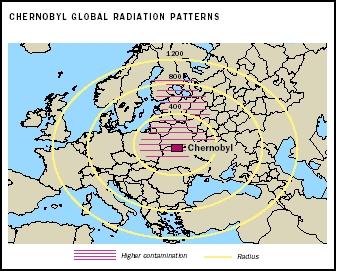Energy, Nuclear
Nuclear energy is produced during reactions in the nucleus of an atom. Atoms can be thought of as miniature solar systems with the nucleus at the center like a sun and electrons orbiting around it like planets. Densely packed neutrons and protons make up the nucleus, which is held together with great force, the "strongest force in nature." When the nucleus is bombarded with a neutron, it can be split apart, a process called fission. Uranium is the heaviest natural element and has ninety-two protons. Because uranium atoms are so large, the atomic force that binds it together is relatively weak, so fission is more likely with uranium than other elements.
Fusion, another type of nuclear reaction, is the joining of atoms and can occur with elements of low atomic number, such as hydrogen, the lightest element, which has one proton. The first time physicists achieved fusion was in the 1950s with the hydrogen bomb. Fusion releases a tremendous amount

Physicists formulated the principles of nuclear power in the early twentieth century. In 1939 German scientists discovered the process of nuclear fission, triggering a race with American scientists to use the massive energy release of fission to create a bomb. The atomic bomb was created by the United States in 1945; it was used to destroy Hiroshima and Nagasaki in Japan at the end of World War II.
After World War II, atomic power was seen as a potential new energy source. The U.S. government thought atomic explosions would be a laborsaving way to dig canals and reservoirs and to mine for gas and oil. As late as

A more successful use of atomic power was nuclear reactors that controlled the release of energy. Admiral Hyman G. Rickover guided the development of small reactors to power submarines, greatly extending their range and power. By the late 1950s, nuclear power was being developed for commercial electric power, initially in England. Morris, Illinois, was the site of the first U.S. commercial reactor. Nuclear weapons research was advanced by Russia and the United States during the Cold War, and a number of other countries, including China and India, have now developed nuclear weapons.
Nuclear Power Plants
Uranium is one of the least plentiful of minerals, making up only two parts per million (ppm) in the earth's crust. But because of its radioactivity, it is a plentiful supply of energy: one pound of uranium has as much energy as three million pounds of coal.
In 2002 there were 104 nuclear power reactors licensed to operate in the United States, and they accounted for 20 percent of the nation's electricity production and more than one-fourth of nuclear power capacity in the world. Many other countries, including France, Japan, and the United Kingdom, have nuclear power plants. Nuclear power accounts for about 80 percent of France's electrical power production.
How Nuclear Power Works
In nuclear power plants, neutrons collide with uranium atoms, splitting them. This split releases neutrons from the uranium that, in turn, collide with other atoms, causing a chain reaction. This chain reaction is regulated (or governed) by "control rods" that absorb neutrons. Fission releases energy that heats water to approximately 520°F in the core of the plant. The steam that is created is then used to spin turbines that are connected to generators, which produce electricity.
After the steam is used to power the turbine, it is cooled off and condensed into water. Some plants use water from rivers, lakes, or the ocean to cool the steam; returning this water to the environment can cause thermal pollution. Other plants use the hourglass-shaped cooling towers that are the familiar hallmark of many nuclear plants. For every unit of electricity produced by a nuclear power plant, about two units of wasted heat are sent into the environment.
Nuclear reactors are also used to power military submarines and surface ships. As in land-based reactors, nuclear-powered vessels use the heat produced by the chain reaction to make steam for a turbine. The turbine is connected to the propeller shafts aboard the ships rather than generators that produce electricity.
Radioactive Pollution from Nuclear Energy
By 1995 over 32,000 metric tons of highly radioactive waste had been produced by American nuclear reactors. That number is expected to rise to 75,000 metric tons by 2015.
Before the mid-1970s, the plan for fuel removed from nuclear reactors was to reprocess it and recycle the uranium into new fuel. Because a by-product of reprocessing is plutonium, a highly unstable element that can be used to make nuclear weapons, President Jimmy Carter ordered the end of reprocessing in 1977 due to security risks. Reprocessing also had a difficult time competing economically with the production of new uranium fuel.
Since then, the U.S. Department of Energy (DOE) has been studying storage sites for the long-term burial of such waste and is now focusing on Yucca Mountain in Nevada. The DOE has built a full-scale system of tunnels in the mountain at a cost of over $5 billion. Although the Yucca Mountain site is still controversial, there are no other sites presently under consideration.
Meanwhile, radioactive waste continues to be stored at the nuclear plants where it is produced. The most common option is to store it in a large steel-lined pool. As these pools fill up, fuel rods are stored in large steel and concrete casks.
SEE ALSO R ADIOACTIVE F ALLOUT ; R ADIOACTIVE W ASTE ; T HERMAL P OLLUTION ; Y UCCA M OUNTAIN .
Bibliography
Mazuzan, George T., and Walker, J. Samuel. (1984). Controlling the Atom: The Beginnings of Nuclear Regulation 1946–1962. Berkeley: University of California Press.
Asimov, Isaac. (1991). Atom: Journey Across the Subatomic Cosmos. New York: Truman Talley Books.
Daley, Michael J. (1997). Nuclear Power: Promise or Peril? Minneapolis: Lerner Publications.
Ramsey, Charles B., and Modarres, Mohammad. (1998). Commercial Nuclear Power: Assuring Safety for the Future. New York: John Wiley & Sons.
Internet Resource
Columbia College Web site. "Nuclear Energy Guide." Available from http://www.spacekid.net/nuclear .
David Lochbaum
Comment about this article, ask questions, or add new information about this topic: